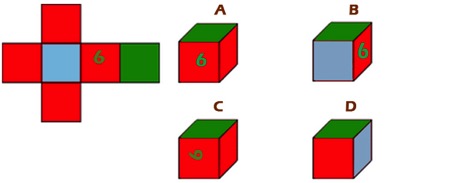Spatial Reasoning
posted by Sasha Fajerstein
As teachers, we constantly remind students about the importance of mathematics if you want to be an engineer, chemist, architect, archaeologist, astronaut, astrologist, biologist, and many more. What people don’t realize is that spatial skills are key in transforming mathematics into three-dimensional objects with limitless uses. Spatial reasoning is essentially the ability to think about, visualize, and mentally organize objects in 3 dimensions.
Here is an example of a standard spatial reasoning test question:
Which of the following cubes represents the unfolded picture on the left?
 Question and photo from http://dudye.com/challenge-your-creativity-77-problem-solving-exercises
Question and photo from http://dudye.com/challenge-your-creativity-77-problem-solving-exercises
The correct answer to the above question is the cube shown in choice C. These visualization exercises involve the same thought processes that allow surgeons to visualize the next steps in surgery, architects to convert floor plans into real life buildings, engineers to use formulas and programs to form electrical circuits, and so on.
Most people think spatial reasoning is specific to geometry class, but spatial reasoning is involved in all mathematics and science classes. I teach high school students, but spatial reasoning skills can be built and expanded from a very early age. We all use our spatial intelligence on a daily basis. When you look at a map to figure out relative location, rearrange your living room, try to figure out if your stroller will fit down the aisle in the grocery store, or decide whether or not that last pan will fit in the dishwasher; you are using your spatial intelligence skill set. Even something as simple as involving your children in these types of questions, decisions, and activities can help strengthen spatial reasoning skills.
Playing with toys and games that allow imaginative building can help improve spatial skills. Some things that probably come to mind immediately are toys like Legos and building blocks, but there are many more options for individual play or group play and board games available. A great list of construction toys is available here: http://astore.amazon.com/parenscien-20?_encoding=UTF8&node=35
There are also countless puzzles and games that involve spatial reasoning skills. A list of board games that involve spatial reasoning is here: http://astore.amazon.com/parenscien-20?_encoding=UTF8&node=35
(Blokus is one of my all-time favorite games! I think playing this game has made me much better at visualizing when teaching geometry.)
If the test question above was interesting for you to think about, there are a number of spatial reasoning challenges and tests you can find online. I did a quick Google search for online spatial reasoning tests and I found one similar to the question above at https://www.123test.com/spatial-reasoning-test/
(This is not a test you’d give young children, but I found it to be a fun mental challenge).
One of the best things about working with construction toys or board games that involve spatial reasoning skills is that they truly are games that allow children to come up with their own plans, outlines, or strategies without one correct answer. This is always the goal of inquiry based mathematics, so introducing games and play objects that allow for this type of thinking early on will go a long way in students’ future success in mathematics.
We have a light table that the children use to build 3d shapes using magnetic tile shapes. They build towers, cubes, garages, etc and it shows how they are able to identify which shapes are needed to create their structure. They learned that using two triangles will make a square.
We also incorporate magnatiles into free play and math activities, letting the children build and fit pieces together.
how can i let my children solve their own spatial reasoning when it comes to sand and water table?
The hokey pokey dance is wonderful for spatial learning!
I use the hokey pokey song for years because its simple and all ages can do it
My loved highlight point: Spatial reasoning is used daily and can be built and further developed at an early age.
When having the children build towers with blocks, talk with the children about which blocks to use and how they can place the blocks to see how tall the tower can be.
I like the idea of incorporating the Hokey Pokey for spatial awareness.
While in the block area I have the children try to put blocks together to make different shapes, we also have magnetic tiles that the children absolutely love, they play with them at the light table by putting them together and making different shapes.
The hockey pokey seems to be the best way to incorporate Spatial Reasoning. When I finally start working in a classroom I will definitely be keeping that in mind and applying that to my daily lesson plan.
I like to incorporate music and using motions that will involve spatial reasoning. The hokey pokey is one, there are many more like Father Abraham, for example.
I liked the example of using construction materials because there is no one correct answer. It leads the children to inquiry and discovery.
I like the idea of using hockey pokey for spatial awarness